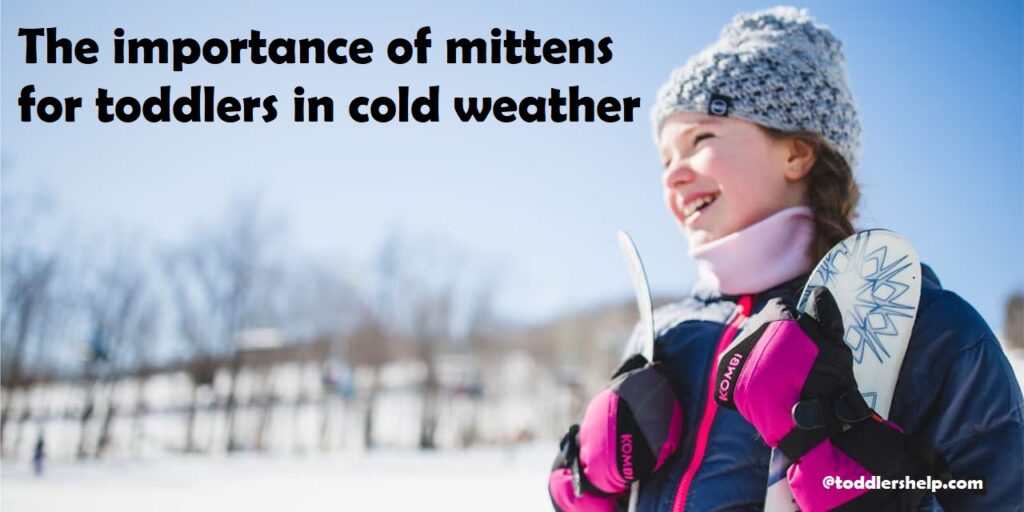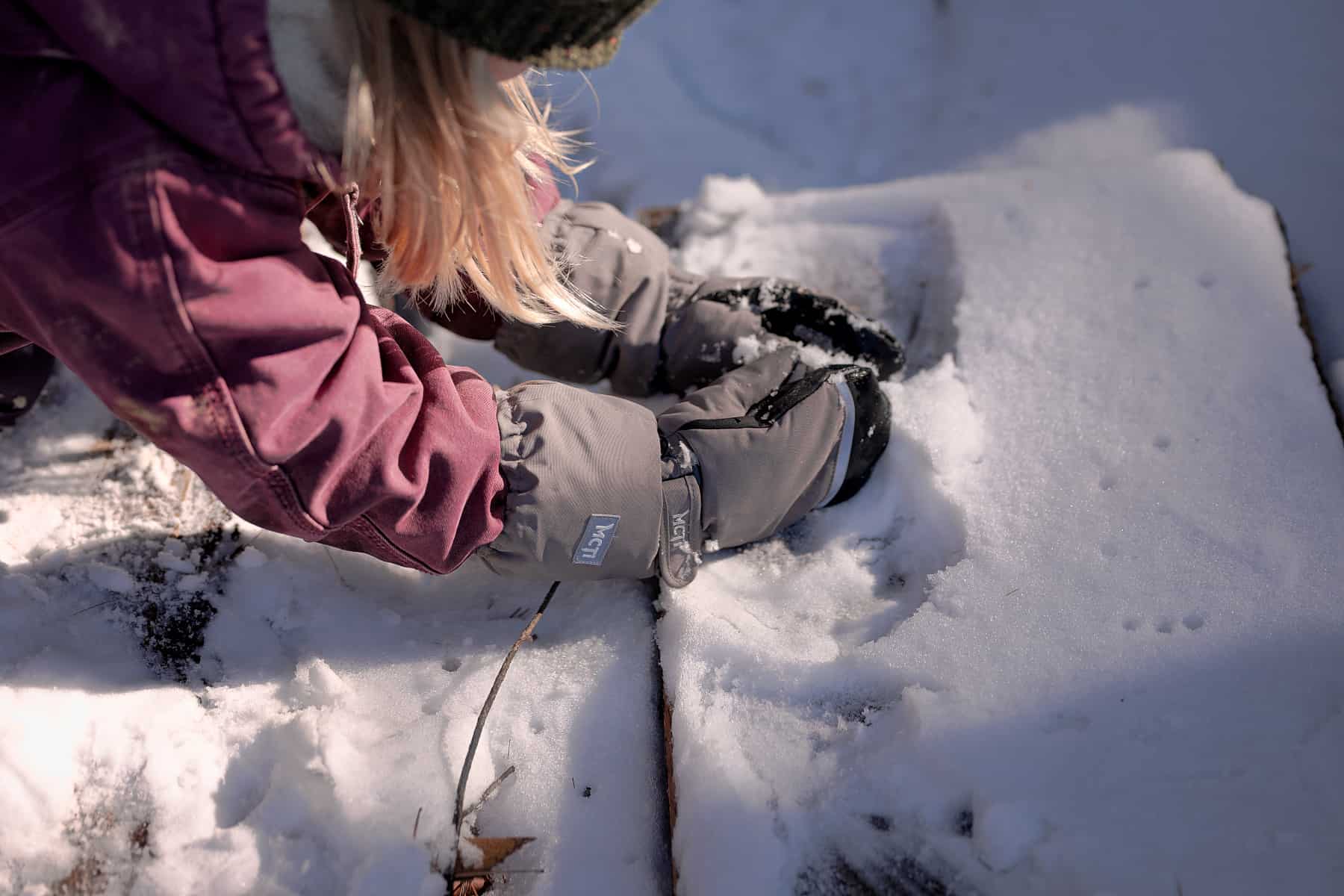Are you worried about your toddler’s exposure to cold weather?
Mittens are a must-have when it comes to protecting hands and fingers from the harsh winter elements. In this article, we’ll discuss the importance of mittens for toddlers in cold weather and provide a complete guide on choosing the right pair. You won’t have to worry anymore, it’s time to keep your little one safe and warm!
Mittens play an important role in keeping toddlers safe and warm in cold weather. This guide will go over why mittens should be worn and the best kinds of mittens for toddlers.
First, it is important to understand that mittens are an essential part of outdoor winter gear for toddlers. Mittens are much more effective at keeping hands warm than gloves since the fingers stay closer together – this ensures that your little one’s fingers can easily create their own warmth by huddling together. Fingerless gloves, while they may look cute and stylish, are not a good choice as they don’t offer enough protection from the cold.
There are a variety of mittens on the market designed specifically for toddlers. It is best to look for thick, insulated options so that your little one’s hands will stay protected even in sub-freezing temperatures. Also be sure to make sure that you get a properly sized pair – depending on your toddler’s age and size it could take anywhere from XS toddler mittens to larger L or XL sizes. A lot of these heavier winter mitts come with adjustable straps so you can make sure they fit snugly but aren’t too tight. Waterproof options can help keep kids’ hands dry during snow days and wet conditions too! Some also feature clever features such as an elastic wristband which helps keep them secured to your little one’s wrists even if they get pulled off as kids like to do!
Explanation of mittens
Mittens may be a more effective item of clothing than gloves in keeping the hands warm when playing in cold weather, especially for toddlers. An important reason why mittens are advantageous is because they allow the index, middle and ring fingers to stay together, which cancels out digits competing for the same heat source. By contrast, each finger of a glove must create its own warmth, thus having a more limited effect on warding off cold temperatures.
Mittens also provide more flexibility with hand function than gloves do, as all four fingers can move together as part of any action performed by the hands and fingers. This means that holding items such as a shovel or a stick can be less cumbersome and require less effort than it would if the child were wearing gloves. Additionally, larger mittens ensure that even if children use their thumbs to hold an object or activity toy such as a mobile phone or puzzle piece respectively; those activities still remain relatively manageable and accessible to do without taking off their mittens.
Importance of mittens for toddlers in cold weather
The importance of mittens for toddlers in cold weather cannot be understated. While most adults know that winter mittens can help keep fingers warm, few understand the significance for young children. Toddlers are especially susceptible to the effects of cold weather, such as frostbite and hypothermia — so it’s important to take extra precaution when dressing them for outdoor activity during cold days.
Due to a lack of insulation and low body fat percentages, toddlers are particularly vulnerable to colder temperatures, as they lose heat more quickly than adults do. For that reason, mittens can provide added protection from the cold by providing warmth and protection from wind. Mittens fit snugly around a baby’s hands to keep them snug but also allow for flexibility of movement. In addition, the loose fitting design allows air circulation between fingers which is essential when temps begin to drop below freezing. It’s best to choose mittens made with waterproof materials such as wool or synthetic fabric blends so that your toddler’s hands remain dry from slushy or wet snow conditions. It’s also a good idea to purchase a pair that has insulation built-in or pack an extra pair with additional liners if in case one gets wet while out playing in the snow.
Finally, consider adding an elastic string onto your child’s mitten loops so they are not easy lost in deep snowbanks or in school playgrounds! Thanks to these small touches of safety and comfort you can ensure your little ones experience all the fun winter has to offer without any risk of being exposed too bitterly cold temperatures near blizzards!
Purpose of the guide
The purpose of this guide is to help parents understand the importance of mittens for toddlers in cold weather.
Mittens are better suited than gloves for toddlers because the mitten design helps maintain warmth and allows the child’s hand to move freely.
This guide will explain in detail about why mittens are important for keeping their hands warm and dry and provide advice on how to choose the right mittens for your toddler. It also includes information on how to care for your mittens so they can be used multiple times as well as tips on when and what to wear with mittens in cold weather.
Ultimately, we want parents to be informed and well-prepared when they purchase winter outerwear items, so every child can stay comfortable and warm during outdoor activities in cooler climates.
Understanding Mittens
Mittens are an essential piece of clothing for toddlers when the weather is cold. They provide protection from the elements and help keep little hands warm by trapping heat. Mittens also give toddlers better control over their hands and reduce the risk of them accidentally scratching their skin when playing outdoors.
Though seemingly simple, there are still many factors to consider when buying mittens for a toddler. Before making your purchase, it is important to understand exactly what mittens can do for a child. Mittens come in various sizes, types and materials depending on the specific child’s needs and preferences.
For example, some mittens are lined or padded for extra warmth, while others come with closures that avoid cold airflow from getting inside the mitten. Furthermore, some mittens contain reflective material which helps keep children visible during inclement weather. Understanding these different features will enable a parent or guardian to make an informed decision about which type of mitten is best suited for a particular winter activity or outing that a toddler may be participating in.
Types of mittens
When selecting mittens for your infant or toddler, you should focus on two major factors: warmth and comfort. The best types of mittens are typically constructed with a combination of natural fibers, like wool, and synthetic fabrics like polar fleece.
Another important consideration is the style of mitten. Traditional slip-on mittens will provide more warmth because they stay securely in place and leave less space for cold air to penetrate, but your toddler may find them harder to take off. Velcro or snap closure mittens provide easy access to cool little hands but may not offer as much protection from the elements. Choose the type that will work best with your toddler’s age and activity level.
Fleece mittens
Fleece mittens are a great option for toddlers in cold weather. They are typically lined with anti-pilling Fleece for warmth, and offer extra protection against the cold. The smooth outer layer of fleece helps ward off wind, rain and snow and the soft loop closure and elastic wrist provides a snug fit that is comfortable for toddlers to wear.
Fleece mittens can be worn under thicker gloves and sleeves to create an extra layer of insulation against the cold. They are available in a variety of colors and sizes so you can find the perfect fit for your toddler.
When shopping for fleece mittens, look for ones that have breathable fabric, an elastic wristband and durable stitching — all features that keep your toddler warm during outdoor play!
Wool mittens
Wool mittens are a great choice when it comes to keeping little hands warm during the colder months. Wool is naturally insulating, water-resistant and breathable, making it an ideal material for outdoor wear. It is also hypoallergenic and non-irritating for babies with sensitive skin.
However, wool can be difficult to care for as it can shrink if washed in hot water or placed in the dryer. To ensure that your wool mittens hold up to wear and last beyond a season, ensure that you follow the care instructions carefully.
Wool friends are also much more expensive than synthetic wool varieties but they are worth the extra money if they will provide protection from cold temperatures during extended periods outdoors.
Synthetic mittens
Synthetic mittens are usually more lightweight than the wool options. They also tend to dry more quickly, but not as rapidly as cotton ones. Though they provide excellent wind protection, synthetic mittens don’t retain heat as well due to the nature of their materials.
However, synthetic gloves are great for toddlers who are involved in a lot of activities where dexterity is needed – like playing with toys or eating meals outdoors. Examples of synthetic mittens include gloves made out of polyester, fleece or down. The material used can help you identify which type of thermoregulation is right for your toddler’s needs depending on the activity and temperature conditions.
The Importance of Mittens for Toddlers in Cold Weather
Mittens are an essential cold-weather items for toddlers because they provide extra warmth and protection needed during outdoor activities. Dressing appropriately for cold weather conditions is critical to prevent toddlers from experiencing hypothermia, frostbite, or chilblains. During the winter months, mittens keep little hands warm and have added benefits like providing a cushioning layer between their fingers and hard surfaces. Mittens also offer protection against other elements such as dirt, snow and ice.
The insulation properties of mittens help to protect your child’s fingers from potential chill caused by handling cold objects within their environment. Many modern mittens are designed with waterproof shells that increase their thermal qualities and reduce water absorption. The thick material also helps to lock in the natural heat of their hands while simultaneously acting as barrier between them and any external elements.
For sizing purposes, it’s important to choose a mitten size that fits snugly around your toddler’s hand so there is no chance of slipping off while they play outside. For optimal performance in colder temperatures, look for insulated materials with a high ‘fill power’ rating or those lined with lambswool or fleece which both add warmth while remaining lightweight and breathable. Additionally look for mittens designed with adjustments such as drawstrings closures or wrist straps that will help to secure the glove in place when your child moves about.
Protection from frostbite
Mittens are essential for the protection of small children from dangerous frostbite in cold weather. Mittens contain multiple layers of material that keep the extremities, such as fingers and toes, warm and protected from temperatures as low as minus-50 degrees Fahrenheit. The tightly-fitting design also helps to prevent heat from escaping, further protecting your child from cold temperatures. It is important to remember that gloves provide less protection since they can allow fingers to touch each other and cool each other off more quickly than mittens do.
Most mittens are made of fibers (such as fleece or wool), polyester fibers (for added insulation), or leather. They also often feature an extra layer of insulated material, such as Thinsulate, for increased warmth and comfort. Many are waterproof or water-resistant to protect against wet elements like snow or rain during outdoor playtime. Make sure to purchase mittens made with the appropriate fabric for your specific environment — lightweight fibers will work best in milder climates while thicker wool will be necessary in colder climates — and make sure they provide a snug fit around your child’s wrist to ensure proper insulation and protection from cold air. Additionally, consider having two pairs of mittens: one for playing outdoors in wet/snowy conditions and another kept as an indoor spare in case the primary set becomes wet on a snowy day.
Finally, it is extremely important when dressing young children for cold weather that you provide additional protection formscarves, hats, snow pants, jackets with hoods.
Increased warmth
When mittens are worn, the fingers together cause a higher production of warmth. The air between each finger is held in the mitten, acting as insulation and creating a warm pocket of air to keep your toddler’s hands protected and warm.
This helps to reduce their exposure to cold temperatures, which can be harmful and extremely uncomfortable for small children. Mittens also provide additional protection from moisture as they are more effective at keeping water out than gloves.
They are soft and provide flexibility in movement, allowing your toddler to move freely without having to constantly remove their hands from mittens or wear them too tight for comfort.
How to Choose the Right Mittens
Mittens are one of the necessary winter items for toddlers, as they help keep fingers and hands warm while playing outdoors. Choosing mittens is not as easy as picking out a colour and size; there are a few purposes to keep in mind when selecting the right mittens for your toddler.
First, it’s important to choose a material that will both keep your child’s fingers warm and give them proper toddling mobility. Mittens need to be loose enough that the child can comfortably move their hands but tight enough so their skin has contact with the fabric. Wool or polyester are good materials that provide warmth and breathability for outdoor playtime.
Next, choose a pair of mittens that fit well around the palms of their hands and wrists so no cold air can get in through gaps. Additionally, some mittens come equipped with straps on one side — these help secure the mitten on your little one’s hand even if they try to take them off themselves!
When buying mittens, make sure you select a pair with waterproof fabric so there is no risk of dampness from rain or melted snow.
Lastly — for those super chilly days — look for mitten liners that fit snugly inside regular mitten shells and provide extra warmth without bulkiness or extra fabric getting in the way of your toddler’s activities.
Conclusion
In conclusion, mittens are a vital cold-weather wardrobe item for toddlers. Mittens can help keep their little hands warm and prevent frostbite and other cold-related issues. They also provide extra protection from wind and wetness if the weather turns wet. Plus, children can be very creative with mittens due to the many colors, patterns, fabrics available in the market.
Toddlers should also make sure to layer up underneath their mittens for added warmth during extended outings in cold temperatures. Having multiple pairs of mittens will make sure your child has warm and dry hands all winter long.
FAQ’S
Should toddlers wear mittens?
Yes, toddlers should wear mittens in cold weather to keep their hands warm and prevent them from getting frostbite.
How do I keep my toddler’s hands warm in the winter?
You can keep your toddler’s hands warm in the winter by dressing them in warm layers, using mittens, and using hand warmers if necessary.
Do babies need winter mittens?
Yes, babies need winter mittens to keep their hands warm and prevent frostbite.
When should kids stop wearing mittens?
Kids can stop wearing mittens when they are able to regulate their body temperature and feel comfortable without them, typically around 6-8 years old.
Are toddlers hands cold if they feel cold?
Yes, toddlers’ hands can feel cold if they are cold, and it’s important to keep them warm to prevent frostbite.
How do I keep my toddler’s hands warm at night?
You can keep your toddler’s hands warm at night by dressing them in warm sleepwear and using a blanket or sleep sack.
What are the disadvantages of baby mittens?
The disadvantages of baby mittens include the risk of the mittens falling off or being too tight, which can limit circulation and cause discomfort.
Should my baby wear mittens all the time?
No, babies should not wear mittens all the time as it can limit their exploration and tactile experiences.
What are the benefits of baby mittens?
The benefits of baby mittens include keeping their hands warm, protecting their skin from scratches, and providing sensory stimulation.
What are the warmest kids mittens?
The warmest kids mittens are typically made of materials such as fleece, wool, or down, and feature insulation and waterproofing for added warmth and protection.
See Also-
- Best toddler soccer cleats
- Best nerf gun for toddler
- Best toddler snow pants
- Best toddler snow boots
- Best toddler slide

